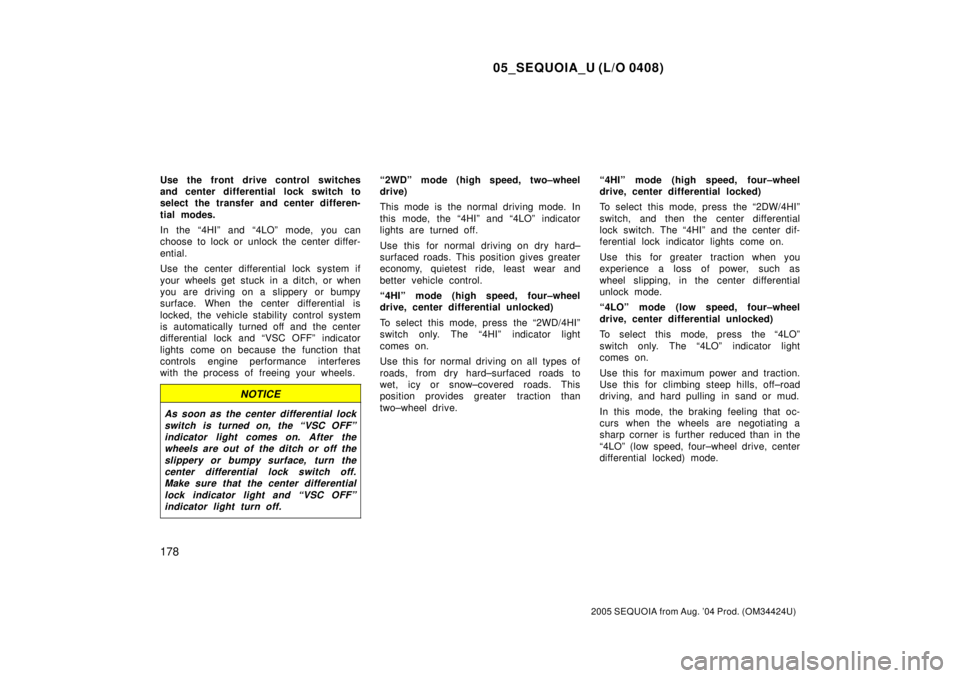Page 3131 of 4323
R13340
SST
Vinyl Tape
F14486
40 mm
(1.57 in.)
F14485
SST
F14522SST
SA2351
SST
± SUSPENSION AND AXLEREAR DIFFERENTIAL CARRIER
SA±127
3123 Author�: Date�:
2005 SEQUOIA (RM1146U)
(b) Using SST and a plastic hammer, install the oil seal until
its surface is flush with the differential carrier end.
SST 09316±12010, 09649±17010
HINT:
Connect 2 SST with vinyl tape.
18. INSTALL COMPANION FLANGE
(a) Place the companion flange.
(b) Coat the threads of a new nut with hypoid gear oil.
(c) 2WD:
Torque the companion flange nut.
(1) Install the 3 stud bolts so that the heads come out
40 mm (1.57 in.).
(2) Set the SST and install the 3 nuts to the companion
flange.
SST 09213±58013
(3) Using SST to hold the flange, torque the nut.
SST 09330±00021
Torque: 147 N´m (1,500 kgf´cm, 109 ft´lbf)
(d) 4WD:
Using SST to hold the flange, torque the nut.
SST 09330±00021
Torque: 147 N´m (1,500 kgf´cm, 109 ft´lbf)
Page 3132 of 4323

SA2352
SA2352
SA±128
± SUSPENSION AND AXLEREAR DIFFERENTIAL CARRIER
3124 Author�: Date�:
2005 SEQUOIA (RM1146U)
19. ADJUST DRIVE PINION PRELOAD
Using a torque wrench, measure the preload of the drive pinion
using the backlash between the drive pinion and ring gear.
Preload (at starting):
New bearing
1.3 ± 1.9 N´m (13 ± 19 kgf´cm, 11.4 ± 16.7
in.´lbf)
Reused bearing
0.8 ± 1.1 N´m (8 ± 11 kgf´cm, 7.0 ± 9.7 in.´lbf)
If the preload is greater than the specified value, replace the
bearing spacer.
If the preload is less than the specified value, retighten the nut
with a force of 13 N´m (130 kgf´cm, 9 ft´lbf) until the specified
preload is reached.
Torque: 451 N´m (4,600 kgf´cm, 333 ft´lbf) or less
If the maximum torque is exceeded while retightening the nut,
replace the bearing spacer and repeat the preload procedure.
Do not loosen the pinion nut to reduce the preload.
20. CHECK TOTAL PRELOAD
Using a torque wrench, measure the total preload with the teeth
of the drive pinion and ring gear in contact.
Total preload (at starting):
Drive pinion preload plus 0.4 ± 0.6 N´m (4 ± 6 kgf´cm,
3.5 ± 5.2 in.´lbf)
21. CHECK RING GEAR BACKLASH
Using a dial indicator, measure the ring gear backlash.
Backlash: 0.13 ± 0.18 mm (0.0051 ± 0.0071 in.)
22. RECHECK TOOTH CONTACT BETWEEN RING GEAR
AND DRIVE PINION (See step 13.)
23. CHECK COMPANION FLANGE RUNOUT
(See page SA±113)
24. STAKE DRIVE PINION NUT
Page 3133 of 4323
SA15R±13
± SUSPENSION AND AXLEREAR DIFFERENTIAL CARRIER
SA±129
3125 Author�: Date�:
2005 SEQUOIA (RM1146U)
INSTALLATION
1. INSTALL DIFFERENTIAL CARRIER ASSEMBLY
(a) Install a new gasket.
(b) Install the differential carrier assembly with the 10 washers and nuts.
NOTICE:
Be careful not to damage the installation surface.
Torque: 73 N´m (740 kgf´cm, 54 ft´lbf)
2. CONNECT REAR PROPELLER SHAFT
2WD: See page PR±5
4WD: See page PR±9
3. INSTALL REAR AXLE SHAFTS (See page SA±102)
4. FILL DIFFERENTIAL WITH HYPOID GEAR OIL (See page SA±105)
Page 3866 of 4323
05_SEQUOIA_U (L/O 0408)
7
2005 SEQUOIA from Aug. '04 Prod. (OM34424U)
18. Ashtray
19. Cigarette lighter
20. Front drive control switches
21. Center differential lock switch
22. Cruise control switch
23. Tire pressure warning system reset
switch
24. Audio remote control switches
25. Tilt steering lock release lever
26. Roll sensing of curtain shield airbag off
switch
27. Instrument panel light control knob
Page 3870 of 4323
05_SEQUOIA_U (L/O 0408)
11
2005 SEQUOIA from Aug. '04 Prod. (OM34424U)
Automatic transmission indicator lights
Traction control system off indicator light
(two±wheel drive models)
Vehicle stability control system off indicator light
(four±wheel drive models) Slip indicator light
Headlight high beam indicator lightOverdrive±off indicator light
Turn signal indicator lights
Engine immobilizer/theft deterrent system
indicator light
Front passenger occupant classification
indicator light
Roll sensing of curtain shield airbags off
indicator light
Headlight low beam indicator light
Tail light indicator lightLow speed four±wheel drive indicator light*
2
High speed four±wheel drive indicator light*
2
Center differential lock indicator light*
2
(four±wheel drive models)
Page 4036 of 4323

05_SEQUOIA_U (L/O 0408)
177
2005 SEQUOIA from Aug. '04 Prod. (OM34424U)
If the automatic unlocking operation linked
to shift lever position is set, all doors are
automatically unlocked when the selector
lever is moved to ªPº position after the
ignition switch is turned to ªONº position.
For details, see ªÐAutomatic door locking
and unlocking functionsº on page 27 in
Section 1±2.
(i) Good driving practice
�If the transmission repeatedly shifts up
and down between fourth gear and
overdrive when climbing a gentle slope,
the overdrive should be turned off. Be
sure to turn the switch on immediately
afterward.
�When towing a trailer, in order to main-
tain engine braking efficiency, do not
use overdrive.
CAUTION
Always keep your foot on the brake
pedal while stopped with the engine
running. This prevents the vehicle
from creeping.
NOTICE
Always use the brake pedal or the
parking brake to hold the vehicle on
an upgrade. Do not attempt to hold
the vehicle using the accelerator ped-
al, as this can cause the transmission
to overheat.
Front drive control switches
Center differential lock switch
Four±wheel drive systemÐ
(a) Front drive control
Page 4037 of 4323

05_SEQUOIA_U (L/O 0408)
178
2005 SEQUOIA from Aug. '04 Prod. (OM34424U)
Use the front drive control switches
and center differential lock switch to
select the transfer and center differen-
tial modes.
In the ª4HIº and ª4LOº mode, you can
choose to lock or unlock the center differ-
ential.
Use the center differential lock system if
your wheels get stuck in a ditch, or when
you are driving on a slippery or bumpy
surface. When the center differential is
locked, the vehicle stability control system
is automatically turned off and the center
differential lock and ªVSC OFFº indicator
lights come on because the function that
controls engine performance interferes
with the process of freeing your wheels.
NOTICE
As soon as the center differential lock
switch is turned on, the ªVSC OFFº
indicator light comes on. After the
wheels are out of the ditch or off the
slippery or bumpy surface, turn the
center differential lock switch off.
Make sure that the center differential
lock indicator light and ªVSC OFFº
indicator light turn off.
ª2WDº mode (high speed, two±wheel
drive)
This mode is the normal driving mode. In
this mode, the ª4HIº and ª4LOº indicator
lights are turned off.
Use this for normal driving on dry hard±
surfaced roads. This position gives greater
economy, quietest ride, least wear and
better vehicle control.
ª4HIº mode (high speed, four±wheel
drive, center differential unlocked)
To select this mode, press the ª2WD/4HIº
switch only. The ª4HIº indicator light
comes on.
Use this for normal driving on all types of
roads, from dry hard±surfaced roads to
wet, icy or snow±covered roads. This
position provides greater traction than
two±wheel drive.ª4HIº mode (high speed, four±wheel
drive, center differential locked)
To select this mode, press the ª2DW/4HIº
switch, and then the center differential
lock switch. The ª4HIº and the center dif-
ferential lock indicator lights come on.
Use this for greater traction when you
experience a loss of power, such as
wheel slipping, in the center differential
unlock mode.
ª4LOº mode (low speed, four±wheel
drive, center differential unlocked)
To select this mode, press the ª4LOº
switch only. The ª4LOº indicator light
comes on.
Use this for maximum power and traction.
Use this for climbing steep hills, off±road
driving, and hard pulling in sand or mud.
In this mode, the braking feeling that oc-
curs when the wheels are negotiating a
sharp corner is further reduced than in the
ª4LOº (low speed, four±wheel drive, center
differential locked) mode.
Page 4038 of 4323

05_SEQUOIA_U (L/O 0408)
179
2005 SEQUOIA from Aug. '04 Prod. (OM34424U)
ª4LOº mode (low speed, four±wheel
drive, center differential locked)
To select this mode, press the ª4LOº
switch, and then press the center differen-
tial lock switch. The ª4LOº and the center
differential lock indicator lights come on.
Use this for maximum power and traction.
Use this for hard pulling in situations the
vehicle cannot negotiate even in ª4LOº
(low speed, four±wheel drive, center differ-
ential unlocked) mode. Also, using this
mode when driving down steep off±road
inclines will help contribute to increased
vehicle stability.
The indicator light tells when the differen-
tial lock is engaged. Note that the differ-
ential is not still locked as long as the
indicator light remains off.
When the operation is not completed, the
indicator blinks. If the indicator light does
not go off when you push out the center
differential lock switch, drive straight
ahead while accelerating or decelerating,
or drive in reverse.
If the center differential lock system op-
eration is not completed within 5 seconds
while the cruise control system is set,
cancel the cruise control system. To can-
cel the cruise control system, see ªCruise
controlº on page 205 in Section 1±7.If the indicator blinks even if doing so,
contact your Toyota dealer as soon as
possible. There may be a trouble in the
center differential lock system.
See ª(c) Shifting procedureº for further in-
structions.
Advice for driving on slippery roads in
ª4LOº (low speed, four±wheel drive)
mode
If you press the ª4LOº switch and shift
the automatic transmission lever to ª2º
when you drive in steep off±road areas,
the output of the brake can be controlled
effectively by the active traction control
system, which assists the driver to control
the driving power of 4 wheels.
Use the ªLº position of the automatic
transmission for maximum power and trac-
tion when your wheels get stuck or when
you drive down a steep incline. The output
of the brake can be controlled by the
active traction control system if the engine
speed is under 3000 rpm (normally engine
speed is under 3000 rpm when the wheels
get unstuck), in the following cases:
�The front drive control in ª4LOº mode
and the automatic transmission in ªLº
or the automatic transmission in ªDº,
ª3º or ª2º with the transmission down-
shifting to the first gear
�The front drive control in ª4LOº mode
and the automatic transmission in ªRº
(As for the automatic transmission shift
positions, see ªAutomatic transmissionº on
page 173 in this Section.)